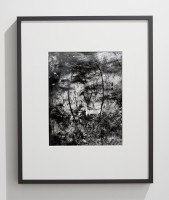Sometime in the early 1930s, Brassaï began making photographs of Parisian graffiti. He had already shot a lot of pictures of classical Parisian scenes– long hedgerowed passages of the Tuileries; the Eiffel Tower at night–but this was something different, on the level of both the subject and scale. The photographs, focusing on the iconography left by the city’s inhabitants, offer close-ups of crumbling walls–most of them found in working-class districts of the city. There are carved faces and dug-outhearts in addition to crude animals and skulls and crossbones rendered with paint and chalk. Brassaï pictured them all similarly, almost as if they were evidence, and one is prompted to compare these specimens with the kinds of graffiti one might encounter today. For starters, there is no color; the general feeling is different. The rich blacks, whites, and grays of Brassaï’s photographs foreground the tactility and texture of these carvings.
In 1933, Brassaï published a spread of these images in the journal Minotaure under the title “Du mur des cavernes au mur d’usine” (From the Cave Wall to the Factory Wall), drawing a link to the cave, and the engravings, depicted in close-up, with all stores or passersby cropped out of the frame, do bear an unmistakeable resemblance to prehistoric carvings. It is nonetheless surprising that Brassaï made the connection to caves; rather than appearing in enclosed spaces of ritual and gathering, these glyphs took shape on the peripheries of the public sphere. They were emphatically graffiti, in other words– an unauthorized form of defacement. It was precisely this outsider status however, that lent them their appeal. Marginalized from official culture, Brassaï’s archive appeared as a “vital” storehouse of frogotten knowledge, and many artists sought to mine it for the radical potential it might contain. Jean Dubuffet, for example, mobilized such material in his long struggle against official culture, but high culture accomodated it as well: The Museum of Modern Art, New York, put on “Language of the Wall: Parisian Graffiti Photographed by Brassaï” in 1956, which comprised some 120 works, a large book, with a preface by Picasso, soon followed.
Seven of Brassaï’s photographs were included here, and while they continue to intrigue, two later works, handwoven tapestries fabricated in 1968, stole the show. Using his extensive archive of graffiti photographs, the artist created a series of large-scale collages, piecing prints together in new configurations. He then took these collages to the atelier of Yvette Cauqil-Prince, who used them to create seven large woolen tapestries. Two, both measuring roughly five feet high by nine-feet wide, were included in this exhibition (one has never been seen in the US before, and the other was only shown one in a New York gallery in 1968 before entering a private collection).
There is something quizzical, almost comical, about these works, which has to do with the way they transfer the grittines of the street onto a tasteful decorative tapestry. In doing so, they seem to foreclose (or internalize) a loss of public space and retreat into the bourgeois interior. Is it a case of radical chic? Perhaps, but if there is something conservative about Brassaï’s gesture, his translation also makes perfect sense: Texture and textile, after all, are etymologically bound together, and these works take great pleasure in sussing out the connection. One could spend an afternoon–many afternoons–letting one’s eye play over the surface of these seductive works, enjoying the anthropomorphic birds, the broken hearts, the gauche details, watching where the dark purples go black, seeing how a feeling of depth is rendered in thread. (One wants to touch them, too.) Their date, of course, is also striking: 1968. In Situationist-inspired students claimed that the beach lay beneath the city’s streets–Sous les pavés, la plage! they cried–Brassaï found a richer world inside the city’s walls. He seems however, to have been increasingly skeptical about their potential for liberation. He chose to enjoy them in private.

